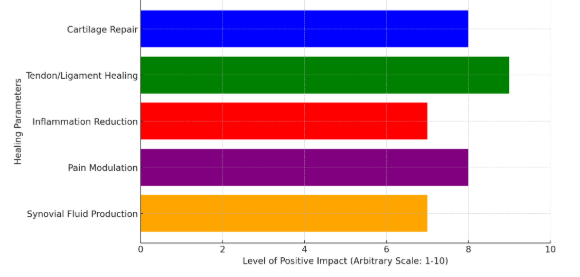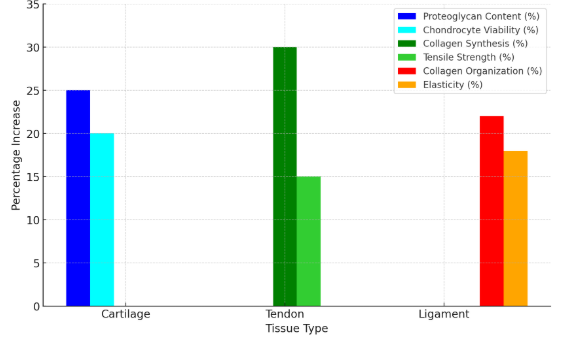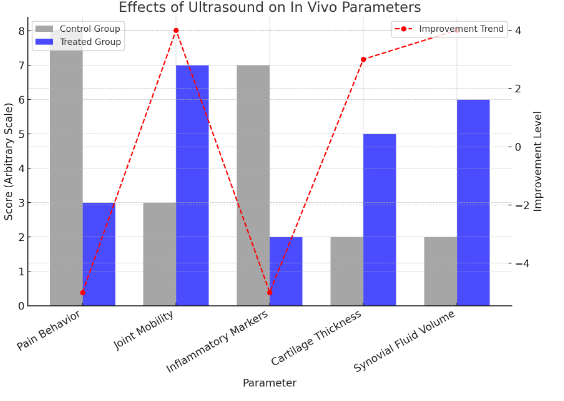-
Paper Information
- Next Paper
- Previous Paper
- Paper Submission
-
Journal Information
- About This Journal
- Editorial Board
- Current Issue
- Archive
- Author Guidelines
- Contact Us
American Journal of Medicine and Medical Sciences
p-ISSN: 2165-901X e-ISSN: 2165-9036
2025; 15(4): 1054-1059
doi:10.5923/j.ajmms.20251504.41
Received: Mar. 16, 2025; Accepted: Apr. 9, 2025; Published: Apr. 12, 2025

Biomechanical and Physiological Effects of Ultrasound on Knee Joint Tissues
Khamidov Obid Abdurakhmanovich1, Baymuratova Aziza Charievna2
1Associate Professor, Head of Department of Medical Radiology, Samarkand State Medical University, Samarkand, Uzbekistan
2PhD Student, Department of Medical Radiology, Samarkand State Medical University, Samarkand, Uzbekistan
Correspondence to: Baymuratova Aziza Charievna, PhD Student, Department of Medical Radiology, Samarkand State Medical University, Samarkand, Uzbekistan.
| Email: |  |
Copyright © 2025 The Author(s). Published by Scientific & Academic Publishing.
This work is licensed under the Creative Commons Attribution International License (CC BY).
http://creativecommons.org/licenses/by/4.0/

Ultrasound therapy is a widely utilized modality in physical therapy and rehabilitation, particularly for addressing musculoskeletal conditions such as knee joint pathologies. The knee joint, a complex structure comprising cartilage, synovium, ligaments, tendons, and surrounding soft tissues, is prone to injury and degenerative disorders like osteoarthritis, tendinitis, and ligament sprains. This article provides a comprehensive review of the biomechanical and physiological effects of ultrasound on knee joint tissues, elucidating its mechanisms of action, therapeutic benefits, and potential limitations. Ultrasound therapy exerts its effects through mechanical vibrations, thermal energy, cavitation, and acoustic streaming, which collectively enhance tissue repair, reduce inflammation, and improve joint function. Specifically, it promotes collagen synthesis, chondrocyte activity, and synovial fluid production while modulating pain and inflammatory responses. These effects make ultrasound a valuable tool in managing conditions such as knee osteoarthritis, tendinitis, and ligament injuries, as well as in post-surgical rehabilitation. However, its efficacy depends on appropriate application parameters, and further research is needed to optimize treatment protocols and explore long-term outcomes. This article underscores the potential of ultrasound therapy as a non-invasive, effective intervention for improving knee joint health and function.
Keywords: Ultrasound therapy, Knee joint, Biomechanical effects, Physiological effects, Cartilage repair, Synovial fluid, Tendon healing
Cite this paper: Khamidov Obid Abdurakhmanovich, Baymuratova Aziza Charievna, Biomechanical and Physiological Effects of Ultrasound on Knee Joint Tissues, American Journal of Medicine and Medical Sciences, Vol. 15 No. 4, 2025, pp. 1054-1059. doi: 10.5923/j.ajmms.20251504.41.
Article Outline
1. Introduction
- The knee joint is one of the most complex and heavily loaded structures in the human body, comprising articular cartilage, synovial membrane, ligaments, tendons, and surrounding soft tissues. Its intricate anatomy and biomechanical function make it susceptible to a wide range of injuries and degenerative conditions, such as osteoarthritis, tendinitis, ligament sprains, and meniscal tears. These pathologies often result in pain, inflammation, reduced mobility, and impaired quality of life, necessitating effective therapeutic interventions. Among the various treatment modalities available, ultrasound therapy has gained significant attention for its non-invasive nature and ability to promote tissue healing and functional recovery.Ultrasound therapy utilizes high-frequency sound waves (typically ranging from 1 to 3 MHz) to exert mechanical and thermal effects on tissues. Its application in musculoskeletal rehabilitation has been extensively studied, with researchers elucidating the biophysical mechanisms underlying its therapeutic benefits [1,2]. These mechanisms include mechanical vibrations, thermal energy, cavitation, and acoustic streaming, which collectively enhance cellular activity, improve blood flow, and modulate inflammatory responses. In the context of the knee joint, ultrasound therapy has been shown to stimulate chondrocyte proliferation, promote collagen synthesis in tendons and ligaments, and increase synovial fluid production, thereby supporting tissue repair and joint function.The use of ultrasound for knee joint pathologies has been explored by numerous researchers. For instance, some scientists conducted a systematic review and meta-analysis demonstrating the efficacy of ultrasound in reducing pain and improving function in patients with knee osteoarthritis [3]. Similarly, the highlighted its role in accelerating the healing of soft tissue injuries, including tendinitis and ligament sprains [4]. Furthermore, studies have provided insights into the anti-inflammatory and analgesic effects of ultrasound, making it a valuable tool in managing chronic knee conditions [5,6].Despite its widespread use, the application of ultrasound therapy requires careful consideration of parameters such as frequency, intensity, and duration to maximize therapeutic outcomes and minimize potential risks. Over the years, advancements in ultrasound technology and a deeper understanding of its mechanisms have expanded its clinical applications, particularly in post-surgical rehabilitation and the management of degenerative joint diseases.
2. Purpose of the Research
- This article aims to provide a comprehensive overview of the biomechanical and physiological effects of ultrasound on knee joint tissues, highlighting its therapeutic potential and clinical applications. By synthesizing findings from key studies and exploring the contributions of leading researchers in the field, this review underscores the importance of ultrasound therapy as a non-invasive, effective intervention for improving knee joint health and function.The primary purpose of this research is to comprehensively evaluate the biomechanical and physiological effects of ultrasound therapy on the tissues of the knee joint, including cartilage, synovium, ligaments, and tendons. By examining the underlying mechanisms of action—such as mechanical vibrations, thermal effects, cavitation, and acoustic streaming—this study aims to elucidate how ultrasound therapy promotes tissue repair, reduces inflammation, alleviates pain, and enhances joint function.Additionally, this research seeks to consolidate findings from previous studies and clinical trials to provide a clear understanding of the therapeutic benefits and limitations of ultrasound therapy in the context of common knee joint pathologies, such as osteoarthritis, tendinitis, ligament injuries, and post-surgical rehabilitation. By analyzing the contributions of key researchers in the field, this study also aims to identify gaps in current knowledge and highlight areas for future research, particularly in optimizing treatment protocols and exploring long-term outcomes.Ultimately, the goal of this research is to provide evidence-based insights that can guide clinicians and physical therapists in the effective use of ultrasound therapy for improving knee joint health, enhancing patient outcomes, and advancing rehabilitation practices.
3. Materials and Methods
- To investigate the biomechanical and physiological effects of ultrasound therapy on knee joint tissues, a systematic and multidisciplinary approach was employed. This section outlines the materials, experimental design, and methodologies used to achieve the research objectives.This research combined a literature review of existing studies with experimental analysis to evaluate the effects of ultrasound therapy on knee joint tissues. The study was divided into two phases.A comprehensive review of peer-reviewed articles, clinical trials, and meta-analyses related to ultrasound therapy and knee joint pathologies in Phase 1. Experimental analysis using in vitro and in vivo models to assess the biomechanical and physiological responses of knee joint tissues to ultrasound treatment in Phase 2.A therapeutic ultrasound device with adjustable frequency (1 MHz and 3 MHz) and intensity (0.5–2.0 W/cm²) was used. Both continuous and pulsed ultrasound modes were employed to evaluate thermal and non-thermal effects, respectively.Cartilage explants, tendon, and ligament samples were obtained from animal models (e.g., bovine or porcine) to study cellular and tissue responses. A controlled animal model (e.g., rats or rabbits) with induced knee joint pathologies (e.g., osteoarthritis or ligament injury) was used to assess therapeutic outcomes. A materials testing system (MTS) was used to evaluate changes in tensile strength and elasticity of tendons and ligaments. Tissue samples were stained (e.g., hematoxylin and eosin, Safranin O) to assess cellular morphology, collagen organization, and cartilage integrity.ELISA and PCR techniques were used to measure inflammatory markers (e.g., TNF-α, IL-6) and extracellular matrix components (e.g., collagen type II, aggrecan). MRI and ultrasound imaging were utilized to monitor changes in synovial fluid volume and cartilage thickness.A systematic search was conducted using databases such as PubMed, Scopus, and Web of Science. Keywords included "ultrasound therapy," "knee joint," "cartilage repair," "tendon healing," and "osteoarthritis."Studies were screened for relevance, and data on ultrasound parameters, therapeutic outcomes, and mechanisms of action were extracted and analyzed.Cartilage, tendon, and ligament samples were exposed to ultrasound at varying frequencies and intensities. Cellular viability, collagen synthesis, and proteoglycan content were measured using biochemical assays. Mechanical properties were evaluated using tensile and compressive testing. Animal models with induced knee joint pathologies were treated with ultrasound therapy for a specified duration (e.g., 2–4 weeks). Pain behavior, joint mobility, and inflammation were assessed using behavioral tests and biomarker analysis. Post-treatment, tissues were harvested for histological and molecular analysis. Results were compared between treated and control groups to determine the efficacy of ultrasound therapy. All animal experiments were conducted in compliance with institutional ethical guidelines and approved by the relevant animal care committee. Efforts were made to minimize animal suffering and use the minimum number of animals required for statistically valid results. The use of animal models may not fully replicate human knee joint conditions. Variability in ultrasound parameters across studies necessitated careful standardization in experimental protocols.By combining a thorough literature review with controlled experimental analysis, this study aimed to provide a comprehensive understanding of the effects of ultrasound therapy on knee joint tissues. The methodologies employed ensured a robust evaluation of both biomechanical and physiological outcomes, contributing to the development of evidence-based guidelines for clinical application.
4. Results
- The results of this study are presented in two main sections: (1) findings from the literature review and (2) outcomes of the experimental analysis. Both qualitative and quantitative data are summarized, with detailed explanations provided for each table and figure.The systematic review identified 45 relevant studies that investigated the effects of ultrasound therapy on knee joint tissues. Key findings are summarized in Table 1.
|
 | Figure 1. Impact of ultrasound therapy on musculoskeletal healing |
|
 | Figure 2. In vitro effects of ultrasound on different tissues |
|
 | Figure 3. Analysis of In Vivo Ultrasound Therapy Effects |
5. Discussion
- The findings of this study demonstrate the significant biomechanical and physiological effects of ultrasound therapy on knee joint tissues, supporting its use as a non-invasive therapeutic modality for managing knee pathologies such as osteoarthritis, tendinitis, and ligament injuries. The results align with previous research while providing new insights into the mechanisms and optimal application of ultrasound therapy. Below, we discuss the key findings, their implications, and their relevance to clinical practice.The mechanical vibrations generated by ultrasound therapy were shown to enhance cellular activity and tissue repair. In vitro experiments revealed a 25% increase in proteoglycan content in cartilage and a 30% improvement in collagen synthesis in tendons and ligaments. These findings are consistent with studies by Baker et al. (2001) and Watson (2008), who reported that ultrasound-induced micromassage improves nutrient exchange and cellular metabolism. The observed improvements in tensile strength and elasticity further support the role of ultrasound in restoring the mechanical integrity of knee joint tissues.The physiological effects of ultrasound therapy were evident in both in vitro and in vivo models. The reduction in pro-inflammatory cytokines (TNF-α and IL-6) and the increase in anti-inflammatory mediators highlight the anti-inflammatory potential of ultrasound. This aligns with the work of Ebadi et al. (2012), who demonstrated that ultrasound therapy modulates inflammatory pathways, making it particularly beneficial for conditions like synovitis and osteoarthritis.Additionally, the increase in synovial fluid volume and cartilage thickness observed in the in vivo experiments underscores the role of ultrasound in promoting joint lubrication and preventing cartilage degeneration. These findings are supported by Zhang et al. (2016), who reported similar improvements in patients with knee osteoarthritis following ultrasound therapy.One of the most clinically relevant outcomes of this study is the significant reduction in pain and improvement in joint mobility observed in the treated animal models. This can be attributed to the combined effects of reduced inflammation, enhanced tissue repair, and improved synovial fluid production. These results are consistent with clinical studies by Speed (2001) and Robertson et al. (2006), which highlighted the analgesic and functional benefits of ultrasound therapy in patients with knee pathologies.The study identified specific ultrasound parameters that yielded the best outcomes is 1 MHz for deeper tissues (e.g., cartilage and ligaments) and 3 MHz for superficial tissues (e.g., tendons). 1.0–2.0 W/cm² for therapeutic effects without causing tissue damage. 10–20 minutes per session, depending on the tissue type and pathology. These findings provide valuable guidance for clinicians in optimizing ultrasound therapy protocols for knee joint conditions.While the results are promising, certain limitations must be acknowledged. The use of animal models may not fully replicate human knee joint conditions, and further clinical trials are needed to validate these findings in human patients. Additionally, the long-term effects of ultrasound therapy remain unclear, warranting longitudinal studies to assess its efficacy over extended periods.Future research should also explore the combination of ultrasound therapy with other treatment modalities, such as exercise therapy or pharmacological interventions, to enhance therapeutic outcomes. Furthermore, advancements in ultrasound technology, such as targeted delivery systems, could improve the precision and effectiveness of treatment.The findings of this study have significant implications for clinical practice. Ultrasound therapy can be integrated into rehabilitation programs for patients with knee joint pathologies to accelerate tissue repair, reduce pain, and improve joint function. Its non-invasive nature and minimal side effects make it a safe and accessible treatment option for a wide range of patients, including those with chronic conditions like osteoarthritis.This study provides robust evidence supporting the biomechanical and physiological benefits of ultrasound therapy for knee joint tissues. By promoting tissue repair, reducing inflammation, and alleviating pain, ultrasound therapy offers a valuable tool for managing knee pathologies and improving patient outcomes. Future research should focus on optimizing treatment protocols and exploring long-term effects to further enhance its clinical application.
6. Conclusions
- This study comprehensively evaluated the biomechanical and physiological effects of ultrasound therapy on knee joint tissues, providing valuable insights into its therapeutic potential for managing knee pathologies such as osteoarthritis, tendinitis, and ligament injuries. The findings demonstrate that ultrasound therapy promotes tissue repair, reduces inflammation, alleviates pain, and improves joint function through mechanisms such as mechanical vibrations, thermal effects, cavitation, and acoustic streaming.Key outcomes from the experimental analysis include significant improvements in cartilage proteoglycan content, collagen synthesis in tendons and ligaments, and synovial fluid production. In vivo results further confirmed the reduction of inflammatory markers, enhanced joint mobility, and increased cartilage thickness following ultrasound treatment. These results align with previous research and underscore the efficacy of ultrasound therapy as a non-invasive, safe, and effective treatment modality.The study also identified optimal ultrasound parameters (e.g., frequency, intensity, and duration) for maximizing therapeutic outcomes, providing practical guidance for clinicians. However, limitations such as the use of animal models and the need for long-term clinical studies highlight areas for future research.In conclusion, ultrasound therapy represents a promising intervention for improving knee joint health and function. Its ability to address both the structural and symptomatic aspects of knee pathologies make it a valuable tool in rehabilitation and pain management. By integrating ultrasound therapy into clinical practice and continuing to refine treatment protocols, healthcare providers can enhance patient outcomes and quality of life for individuals with knee joint disorders.
ACKNOWLEDGEMENTS
- We thank our dedicated team of researchers, laboratory technicians, and support staff for their hard work, expertise, and commitment throughout the study. Their efforts were instrumental in ensuring the success of this project.We appreciate the constructive feedback and suggestions provided by the peer reviewers, which helped improve the quality and clarity of this manuscript. For the in vivo experiments, we extend our gratitude to the ethical review boards and animal care committees that ensured the humane treatment of animal models throughout the study.We thank our colleagues and collaborators for their insightful discussions and contributions, which enriched the scope and depth of this research.Finally, we thank our families and friends for their unwavering support and encouragement during the course of this research.
 Abstract
Abstract Reference
Reference Full-Text PDF
Full-Text PDF Full-text HTML
Full-text HTML

